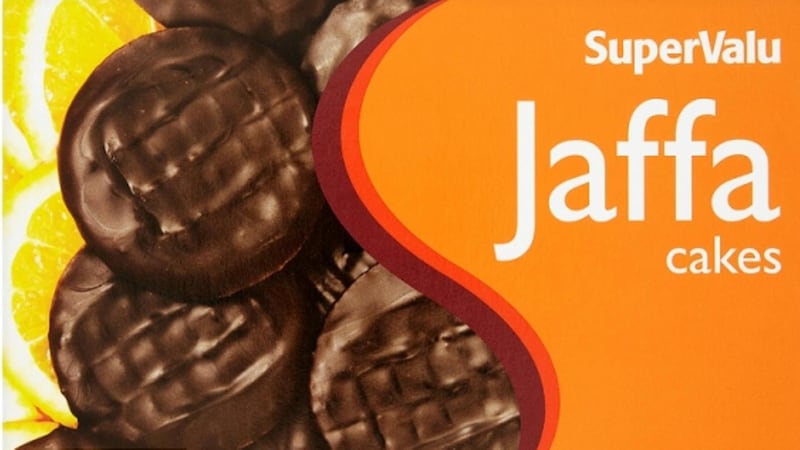Ever since hearing that the England football team takes Jaffa cakes when it goes on tour, I’ve looked at them with fresh eyes. What is it about the spongy treat that makes it so popular? If athletes eat them, does that mean they qualify as a healthy option?
Jaffa cakes were first made by McVitie’s and Price in the UK in 1927. The original was a little sponge topped with jam and a layer of chocolate. There is quite a lot more in there now however. There are also a lot more brands, though the distinction between them seems to be on price and marketing, rather than recipe, with own-brand Jaffa cakes from Jacob’s, Aldi, Lidl, Centra, Supervalu and Dunnes, for example.
So what’s the difference?
McVitie’s wins on marketing. The packaging even mentions its Jaffa cake Facebook page, which has thousands of followers. It also says: “To find out how exercise and a balanced diet can help a healthy lifestyle, visit www.123healthybalance.com.” That is a fairly standard website run by United Biscuits, which owns McVitie’s and is in turn owned by Yildiz Holding, a Turkish food conglomerate. It dishes out uncontroversial advice to eat a balanced diet and get some exercise.
Starch industry
When it comes to ingredients, McVitie’s sets the tone and lists more than 30. It’s hard to give an exact number and some are mentioned as “and/or”. So they may or may not be there. The first ingredient on the list is glucose-fructose syrup and it makes up at least 19 per cent of the ingredients, though probably much more. In the European Union, the fructose content of glucose-fructose syrup is usually about 20 to 30 per cent and it is made from wheat or maize,according to the Starch Europe, a trade association that represents the interests of the starch industry. In the United States, it is often known as high-fructose corn syrup as it is predominately made from corn, and can be up to 50 per cent fructose. So it is similar, though not the same, as the type of sugar used in fizzy drinks in the US. Manufacturers love it because it can provide texture, volume, taste, glossiness, improved stability and a longer shelf life.
It is just one of four ways the cake is sweetened, the others being sugar, dextrose monohydrate and glucose syrup. Look at the nutrition panel and you will see the finished cake is about 50 per cent sugar, which seems high. For comparison, a chocolate cake and a McVitie’s ginger cake each were about 40 per cent sugar. It also uses “whole egg” and “dried whole egg”, which seems odd. If the company is going to the bother of using whole eggs, why add dried egg?

Ingredient list
The full list of ingredients is: glucose-fructose syrup, plain chocolate (19 per cent) [sugar, cocoa mass, vegetable fats (palm, sal and/or shea), butter oil (milk), cocoa butter, emulsifiers (soya lecithin, E476), natural flavouring], sugar, flour (wheat flour, calcium, iron, niacin, thiamin), whole egg, water, dextrose monohydrate, concentrated orange juice (8 per cent orange juice equivalent), glucose syrup, vegetable oils (sunflower, palm), humectant (glycerine), acid (citric acid), gelling agent (pectin), emulsifiers (E471, soya lecithin), raising agents (ammonium bicarbonate, disodium diphosphate, sodium bicarbonate), dried whole egg, acidity regulator (sodium citrate), natural orange flavouring and colour (curcumin). Many of these ingredients I have looked at before or will do again, because the list is too long to go into here.
Jaffa cakes sold by Valeo Foods under the Jacob’s brand are no better. They cost far more, but it’s hard to see why. They are not made here but are imported from the UK. (It also supplies other brands such as Centra.) The first ingredients on the list are glucose-fructose syrup, followed by sugar. There are three types of sugar in the recipe, which also has maltodextrin. So the finished cake is about 50 per cent sugar like those of its competitors. Ingredient lists are very similar.
Where McVitie’s uses E476, Jacob’s has polyglycerol polyricinoleate. It’s the same thing. This emulsifier was re-evaluated last year by the European Food Safety Authority and found to be fine for human consumption when not taken to excess. There is little to choose between any of the brands. The difference comes down to price and taste preference.
Jaffa cakes used to be popular because they are low in fat. But that’s not a reason to eat them. Have them because they are scrumptious as does the England team.
FOOD LABELS SERIES
1) Being a successful shopper
2) Bread
3) Milk
4) Cereal
5) Rashers
6) Yoghurt
7) Soup
8) Hummus
9) Pasta sauce
10) Chinese ready meals
11) Frozen chips
12) Chilled fish
13) Egg
14) Chicken Kiev
15) Crisps
16) Mayonnaise
17) Baked beans
18) Tomato ketchup
19) Chocolate digestive biscuits
20) Avocados
21) Cadbury's Dairy Milk
22) Dark chocolate
23) Salad Cream
24) Pesto sauce
25) Smoothies
26) Sliced ham
27) Vanilla ice cream
28) Ice-pop
29) Jaffa cakes
30) Protein bars
31) Energy bars
32) Chicken Tikka Masala
33) MiWadi
34) Peanut butter



















